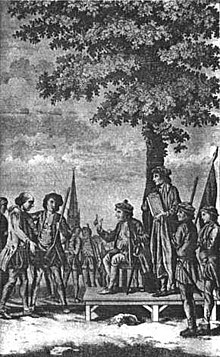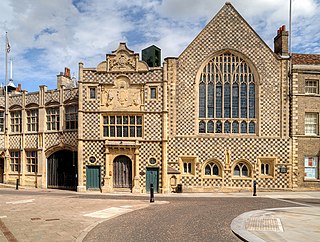
Norfolk is a ceremonial county in the East of England and East Anglia. It borders Lincolnshire and The Wash to the north-west, the North Sea to the north and east, Cambridgeshire to the west, and Suffolk to the south. The largest settlement is the city of Norwich.
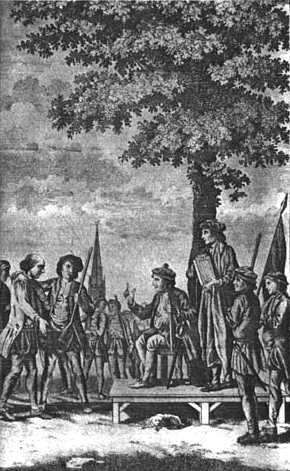
Kett's Rebellion was a revolt in Norfolk, England during the reign of Edward VI, largely in response to the enclosure of land. It began at Wymondham on 8 July 1549 with a group of rebels destroying fences that had been put up by wealthy landowners. One of their targets was yeoman Robert Kett who, instead of resisting the rebels, agreed to their demands and offered to lead them. Kett and his forces, joined by recruits from Norwich and the surrounding countryside and numbering some 16,000, set up camp on Mousehold Heath to the north-east of the city on 12 July. The rebels stormed Norwich on 29 July and took the city. On 1 August the rebels defeated a Royal Army led by the Marquess of Northampton who had been sent by the government to suppress the uprising. Kett's rebellion ended on 27 August when the rebels were defeated by an army under the leadership of the Earl of Warwick at the Battle of Dussindale. Kett was captured, held in the Tower of London, tried for treason, and hanged from the walls of Norwich Castle on 7 December 1549.

Wymondham is a market town and civil parish in the South Norfolk district of Norfolk, England, 12 miles (19 km) south-west of Norwich off the A11 road to London. The River Tiffey runs through. The parish, one of Norfolk's largest, includes rural areas to the north and south, with hamlets of Suton, Silfield, Spooner Row and Wattlefield. It had a population of 14,405 in 2011, of whom 13,587 lived in the town itself.

Walter "Wat"Tyler was a leader of the 1381 Peasants' Revolt in England. He led a group of rebels from Canterbury to London to oppose the institution of a poll tax and to demand economic and social reforms. While the brief rebellion enjoyed early success, Tyler was killed by officers loyal to King Richard II during negotiations at Smithfield, London.

The Bloody Assizes were a series of trials started at Winchester on 25 August 1685 in the aftermath of the Battle of Sedgemoor, which ended the Monmouth Rebellion in England.

Robert Kett was the leader of Kett's Rebellion.
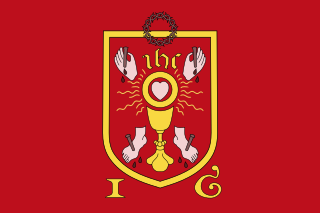
The Pilgrimage of Grace was a popular revolt beginning in Yorkshire in October 1536, before spreading to other parts of Northern England including Cumberland, Northumberland, Durham and north Lancashire, under the leadership of Robert Aske. The "most serious of all Tudor period rebellions", it was a protest against Henry VIII's break with the Catholic Church, the dissolution of the lesser monasteries, and the policies of the King's chief minister, Thomas Cromwell, as well as other specific political, social, and economic grievances.

Norwich Castle is a medieval royal fortification in the city of Norwich, in the English county of Norfolk. William the Conqueror (1066–1087) ordered its construction in the aftermath of the Norman Conquest of England. The castle was used as a gaol from 1220 to 1887. In 1894 the Norwich Museum moved to Norwich Castle. The museum and art gallery holds significant objects from the region, especially works of art, archaeological finds and natural history specimens.

Norfolk is a rural county in the East of England. Knowledge of prehistoric Norfolk is limited by a lack of evidence — although the earliest finds are from the end of the Lower Paleolithic period. Communities have existed in Norfolk since the last Ice Age and tools, coins and hoards such as those found at Snettisham indicate the presence of an extensive and industrious population.

Hethersett is a large village and electoral ward in the county of Norfolk, England, about 6 miles (10 km) south-west of Norwich. It covers an area of 4.22 sq mi (10.9 km2) and had a population of 5,441 in 2,321 households at the 2001 census, increasing to 5,691 at the 2011 census. In 2013 Hethersett became the first village or town in the United Kingdom to receive a Prime Minister's Big Society Award for its outstanding contribution to the Olympic legacy and sport and fitness in general.

John Rolph was a Canadian physician, lawyer, and political figure. He was elected to the Parliament of Upper Canada in 1824 to represent Middlesex County and was considered the leader of the Reform faction in the 1820s. In 1837 he helped plan the Upper Canada Rebellion, but acted as the government's emissary to negotiate a truce once the rebellion began. In the 1850s he was elected to the newly-formed Parliament of the Province of Canada, representing Norfolk County, and was appointed as Minister of Crown Lands and Minister of Agriculture. He founded several medical schools throughout his life, including the Rolph School, and incorporated new teaching techniques and medical practices into his lectures. His actions against rival medical schools decreased public confidence in the ability of medical professionals to regulate themselves.
Tooke is an Old English name originally found predominantly in the East Anglia region of the United Kingdom.Tooke is said to be derived "from the Old Swedish personal name "Toki". Toki remained a personal name from the Old Scandinavian, through the Anglo-Norman, and Middle English periods.
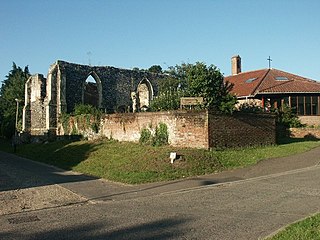
Bowthorpe is a suburban village to the west of Norwich, in the county of Norfolk, England.
Events from the year 1803 in Ireland.

Hethersett was a railway station near Hethersett, Norfolk.

Forncett is a civil parish in the English county of Norfolk. It covers an area of 10.76 km2 (4.15 sq mi) and had a population of 1,000 in 381 households at the 2001 census, increasing to 1,126 at the 2011 census. For the purposes of local government, it falls within the district of South Norfolk.
Kett is a surname. Notable people with the surname include:
Edward Flowerdew, was an English judge and MP.


